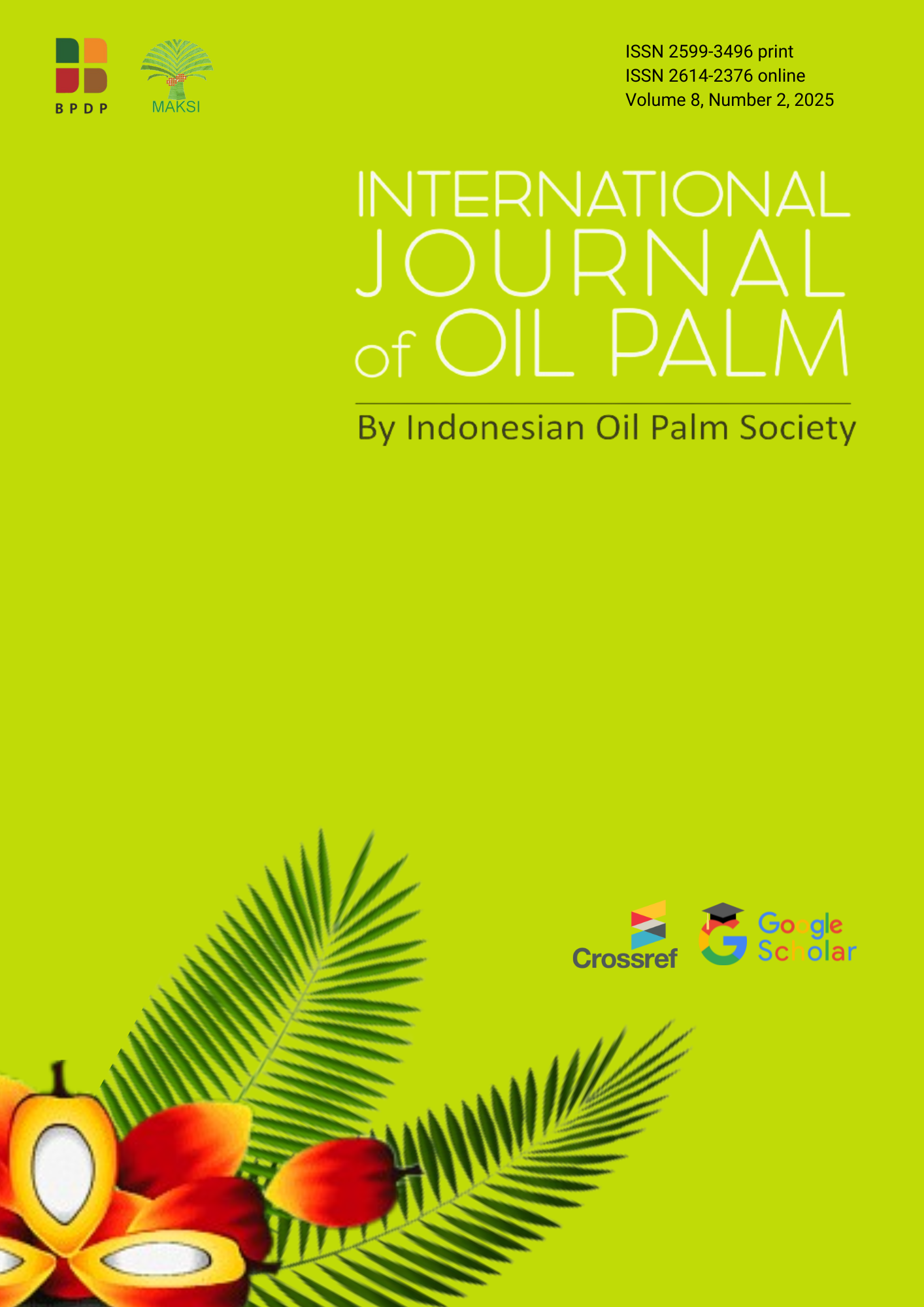Slow Release Granular Biosilica Fertilizer for Peatland Oil Palm Cultivation
DOI:
https://doi.org/10.35876/ijop.v8i2.140Keywords:
Azotobacter, biochar, biomass, CEC improvement, Nutrient uptakeAbstract
Indonesia’s tropical peatlands, covering over 14.9 million hectares, are critical for palm oil production but face severeagronomic constraints due to extreme acidity (pH 3.0–4.5), high water retention, low nutrient availability, and poor cation exchange capacity (CEC < 20 cmol(+)/kg). This study develops a slow-release granular biofertilizer tailored for oil palm grown in peat soils. The formulation integrates biosilica derived from calcined empty fruit bunch (EFB) ash, palm biochar, nutrient-rich fermented oil palm biomass, andAzotobacter sp. Biosilica was obtained by calcining EFB ash at 800°C for 4 hours, followed by acid leaching with 1% HCl, dissolution in 2 M NaOH for 2 hours, and precipitation using 3 M NH?OH at 50 °C until reaching neutral pH. The resulting amorphous silica was driedand blended with biochar and 5% cassava starch binder to produceporous granules. These were enriched with Azotobacter sp. (10?CFU/g) and composted biomass as sources of slow-releasing organic NPK. Field-simulated trials in peat soils showed that the formulationraised soil pH by 0.8–1.2 units, improved CEC by up to 54%, andenhanced nutrient uptake: nitrogen by 49.7%, phosphorus by 16.2%, and potassium by 35% compared to controls. The granules maintained structural integrity under saturated conditions and released nutrientssteadily over 30–45 days, aligning with crop demand while minimizing leaching losses. This innovative, peat-specific formulation addresses key soil limitations by improving nutrient retention, buffering acidity, and introducing biological nitrogen fixation. It offers a scalable and eco-compatible solution to enhance the sustainability and productivity of palm plantations on degraded peatlands.
Downloads
References
Faizul, C. P., Abdullah, C., Fazlul, B., & Noorina, H. J. (2014). Extraction of silica from palm ash using organic acid leaching treatment. Key Engineering Materials, 594–595, 329–333.
Husnain, H., Sipahutar, I. A., Purnomo, J.,Widyanto, H., & Nurhayati, N. (2017). CO? emissions from tropical peat soil affected by fertilization. Journal of Tropical Soils, 22(1), 1–9.
IOPRI.?(2016).?Indonesian?oil?palm??on peatlands??has?been??4??generations. Diakses?pada??14?Juli???2025?dari https://perkebunannews.com/ppks-sawit- indonesia-di-lahan-gambut-sudah-4- generasi.
Luthfiah, A., Deawati, Y., Firdaus, M. L., Rahayu, I., & Eddy, D. R. (2021). Silica from natural sources: a review on the extraction and potential application as a supporting photocatalytic material for antibacterial activity. Science and Technology Indonesia, 6(3), 144–155.
Mishra, S. P., Mohanty, L. K., Padhiary, A. K., & Rout, S. (2021). Azotobacter: Nitrogen fixing bio-fertilizer for sustainable agriculture. Dalam S. Rout (Ed.), Agriculture and Forestry: Current Trends, Perspectives, Issues – IV (hlm. 96–98). Immortal Publications. ISBN: 978-93-5437-486-9.
Nuryani Hidayah Utami, S., Kusumawardani, P. N., Maftu’ah, E., Noor, M., Masganti, Wakhid, N., ... & Karolinoerita, V. (2024). Empty Fruit Bunch Oil Palm Ash and Biochar Improved Peat Soil Properties, NPK Status on Leaves, and the Growth of Immature Oil Palm Plantations. Applied and Environmental Soil Science, 2024(1), 1133527.
Rauf, A., & Harahap, F. S. (2019, November). Evaluation of peat soil properties for oil palm plantation in nine years of plant at Kubu Raya District, West Kalimantan, Indonesia. Dalam IOP Conference Series: Earth and Environmental Science (Vol. 374, No. 1, p. 012040). IOP Publishing.
Utami, S. N. H., & Indrawati, U. S. Y. V. (2024). Oil palm empty fruit bunch biochar fertilizer as a solution to increasing the fertility of peat soil for sustainable agriculture. International Journal of Recycling of Organic Waste in Agriculture, 13(1).
Downloads
Published
How to Cite
Issue
Section
Citation Check
License
Copyright (c) 2025 Luis Ibanez, Mayada Jannati

This work is licensed under a Creative Commons Attribution-ShareAlike 4.0 International License.




